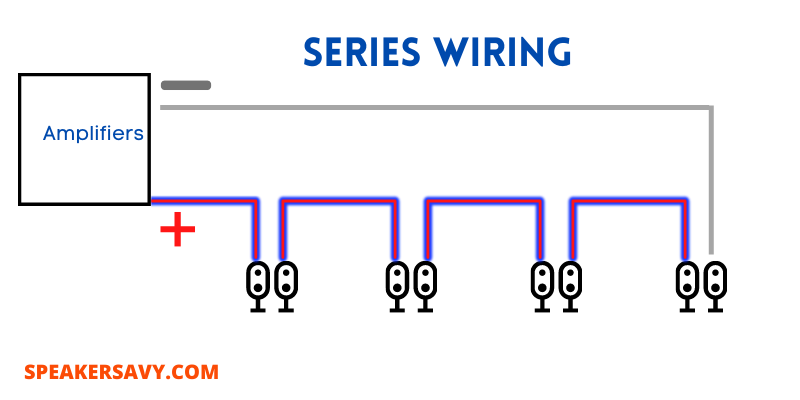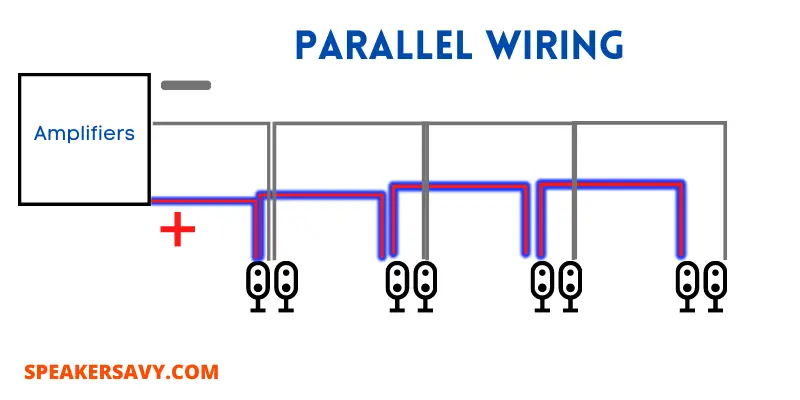An audiophile can connect multiple speakers to a 2 channel amplifier through several means. Though they can be easily connected, one needs to be aware of the impedance and certain limits that should not be crossed.
Be cautious when it comes to connecting 4 speakers to the 2-channel amplifier and check the minimum and maximum level of impedance of the amp to stay within limits.
How to Connect 4 Speakers to a 2 Channel Amp?
Contrary to popular belief, four speakers can be connected to the 2 channel amplifier in multiple ways. Stay within the limits while connecting multiple speakers to not overload the amp.
Most amplifiers remain functional and handle the power unless the audio is being played at demolition volume levels.
Two of the popular ways to connect 4 speakers to a dual-channel amplifier is using a series or parallel configuration.
Which Method is Better, Series or Parallel?
Whether to use a series or parallel method depends on the maximum and minimum impedance of the amplifier. The impedance or load should not be less or exceed the limit.
Check the amplifier’s impedance from the manual then calculate the impedance of speakers connected to one channel, if it is within limits, go for the series circuit.
If it is not possible to connect them in series, opt for the parallel method. However, if the impedance is within limits using both ways, go for either of them.
Connecting 4 Speakers Using Series configuration

Though this kind of configuration is not always recommended, it is certainly possible to get the most out of speakers. Understand the ohms and limits of the devices for them to work together to produce loud sound to the fullest extent.
4 speakers and a dual-channel amp are the best match and if you have decided for a series connection, here’s how it works.
1. Locate the Positive and Negative Terminals of the Amp
Finding the positive and negative terminal on the amplifier is quite easy which can be identified by the simple + and – signs.
2. Connect Positive Terminals of the Speakers
Connect the positive terminal of the amplifier to the positive terminal of the first speaker in the series. Now, wire the positive terminal of the first speaker to the next one. Repeat the steps with all speakers to connect them together.
3. Connect the Final Speaker to the Amplifier
Lastly, connect the negative terminal of the final or 4th speaker to the negative terminal of the amplifier. This closes the circuit and makes sure all the connections are tight.
Connecting 4 Speakers Using Parallel Configuration

Audiophiles are always seen arguing about the series and parallel connection. Though it seems like an endless debate, most people agree that parallel connection sounds better and louder with minimum resistance.
In this configuration, all the speakers are connected in a daisy chain. This type of connection is similar to connecting all the speakers directly to the amp.
- Step 1 – Wire the left positive and negative terminal of the 2-channel amplifier to the related terminals of one of the left speakers.
- Step 2 – Connect a couple of wires from the similar positive and negative terminals of the amplifier to the relevant terminal of the left speaker. A similar process should be followed for the right pair of speakers.
Connecting Amplifier and Speaker with Selector Switch
The Speaker selector switch is an additional accessory that ensures the safety of the setup process. Of all three methods, it is the safest and easiest way to connect all four speakers to the amplifier.
All four speakers are connected individually similar to the aforementioned method to the selector switch which, in turn, is wired to the amplifier’s output.
Expert Tips
The key is to not overload the amp, otherwise, you may risk damaging it.
There is a limit to the amplifier’s power handling capacity, it can not do more than its ability.
Make sure that the audio devices are compatible by checking their impedance.
Do not make it work beyond its capacity as it will lead to distortion and struggle to reproduce bass.
Do not forget to read the user manual thoroughly and follow all the safety instructions given.
Conclusion
It is up to you to decide which method to use, weigh up their pros and cons, and see which one suits you the best.

